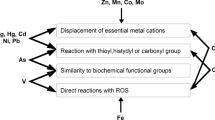Abstract
Individuals of Mytilus edulis (collected from Sequim Bay, Washington, in April and August, 1980) were exposed to 5 μg l-1 mercury as HgCl2 for 28 d. Gill mercury accumulation, mercury incorporation into the soluble fraction and low molecular weight, mercury-binding proteins of gills, and induction of these mercury-binding proteins were determined as a function of time. Short-term mercury uptake rates of excised gills were also determined for mussels sampled at intervals during exposure. Gill mercury accumulation occurred in three phases, represented by net uptake phases initially (up to Day 4) and toward the end of the exposure (Days 15 to 28), and an intermediate stable phase (Days 4 to 15). The stable phase was associated with induction of the predominant mercury-binding proteins and mercury incorporation into the proteins. After Day 15, the mercury-binding proteins were saturated and spillover of mercury into high molecular weight proteins had occurred. This was associated with saturation of the soluble fraction, increases of mercury on particulate fractions, and a loss of the ability of gills to maintain stable mercury concentrations. Mercury uptake rates of gills were not affected by the 28 d exposure of the whole organism.
Similar content being viewed by others
Literature Cited
Anderson, J. W. and W. B. Bedford: The physiological response of the estuarine clam, Rangia cuneata (Gray), to salinity. II. Uptake of glycine. Biol. Bull. mar. biol. Lab., Woods Hole 144, 229–247 (1973)
Bothner, M. H. and D. E. Robertson: Mercury contamination of sea water samples stored in polyethylene containers. Analyt. Chem. 47, 592–595 (1975)
Brown, D. A., C. A. Bawden, K. W. Chatel and T. R. Parsons: The wildlife community of Iona Island jetty, Vancouver, B. C., and heavy-metal pollution effects. Envir. Conserv. 4, 213–216 (1977)
Brown, D. A. and T. R. Parsons: Relationship between cytoplasmic distribution of mercury and toxic effects to zooplankton and chum salmon (Oncorhynchus keta) exposed to mercury in a controlled ecosystem. J. Fish. Res. Bd Can. 35, 880–884 (1978)
Cunningham, P. A. and M. R. Tripp: Accumulation, tissue distribution and elimination of 203HgCl2 and CH3 203 HgCl in the tissues of the American oyster Crasostrea virginica. Mar. Biol. 31, 321–334 (1975)
Engel, D. W. and B. A. Fowler: Factors influencing cadmium accumulation and its toxicity to marine organisms. Envir. Hlth Perspectives 28, 81–88 (1979)
Fitzgerald, W. F. and G. A. Gill: Subnanogram determination of mercury by two-stage gold amalgamation and gas phase detection applied to atmospheric analyses. Analyt. Chem. 50, 1714–1720 (1979)
Frankenne, F., F. Noel-Lambot and A. Disteche: Isolation and characterization of metallothioneins from cadmium-loaded mussel Mytilus edulis. Comp. Biochem. Physiol. 66C, 179–182 (1980)
George, S. G., E. Carpene, T. L. Coombs, J. Overnell and A. Youngson. Characterization of cadmium-binding protein from mussels, Mytilus edulis (L.), exposed to cadmium. Biochim. biophys. Acta 580, 225–233 (1979)
George, S. G. and B. J. S. Pirie: The occurrence of cadmium in subcellular particles in the kidney of the marine mussel, Mytilus edulis, exposed to cadmium. Biochim. biophys. Acta 580, 234–244 (1979)
Hart, B. A. and R. F. Keating: Cadmium accumulation and distribution in human lung fibroblasts. Chem. biol. Interactions 29, 67–83 (1980)
Marshall, A. T. and V. Talbot: Accumulation of cadmium and lead in the gills of Mytilus edulis: X-ray microanalysis and chemical analysis. Chem. biol. Interactions 27, 111–123 (1979)
Noel-Lambot, F.: Distribution of cadmium, zinc, and copper in the mussel Mytilus edulis. Existence of cadmium-binding proteins similar to metallothioneins. Experientia 32, 324–326 (1976)
Pruell, R. J. and F. R. Engelhardt: Liver cadmium uptake, catalase inhibition and cadmium thionein production in the killifish (Fundulus heteroclitus) induced by experimental cadmium exposure. Mar. envirol Res. 3, 101–111 (1980)
Ridlington, J. W. and B. A. Fowler: Isolation and partial characterization of a cadmium-binding protein from the American oyster (Crassostrea virginica). Chem. biol. Interactions 25, 127–138 (1979)
Roesijadi G.: Influence of copper in the clam Protothaca staminea: effects on gills and occurrence of copper-binding proteins. Biol. Bull. mar. biol. Lab., Woods Hole 158, 127–138 (1980)
Roesijadi, G.: The significance of low molecular weight, metallothionein-like proteins in marine invertebrates: current status. Mar. envirol Res. 4, 167–179 (1981)
Roesijadi, G. and A. S. Drum. Influence of mercaptoethanol on the isolation of mercury-binding proteins from the gills of Mytilus edulis. Comp. Biochem. Physiol. (C). (In press).
Roesijadi, G., A. S. Drum and J. R. Bridge. Mercury in mussels of Bellingham Bay, Washington (USA). In: Biological monitoring of marine pollutants, pp 357–376. Ed. by A. Calabrese, W. Vernberg, F. P. Thurberg and F. J. Vernberg. New York: Academic Press 1981
Roesijadi, G. and R. E. Hall: Characterization of mercury-binding proteins from the gills of marine mussels exposed to mercury. Comp. Biochem. Physiol. 70C, 59–64 (1981)
Stewart, M. G. and D. R. Bamford: Kinetics of alanine uptake by the gills of the soft-shelled clam Mya arenaria. Comp. Biochem. Physiol. 52A, 67–74 (1975)
Talbot, V., and R. J. Magee: Naturally-occurring heavy metal-binding proteins in invertebrates. Archs envir. Contam. Toxicol. 7, 73–81 (1978)
Viarengo, A., M. Pertica, G. Mancinelli, G. Zanicchi and M. Orunesu. Rapid induction of copper-binding proteins in the gills of metal exposed mussels. Comp. Biochem. Physiol. 67C, 215–218 (1980)
Winge, D., J. Krasno and A. V. Colucci: Cadmium accumulation in rat liver: correlation between bound metal and pathology. In: Trace element metabolism in animals-2, pp 500–502. Ed. by W. G. Hoekstra, J. W. Suttie, H. E. Ganther, and W. Mertz. Baltimore: University Park Press 1973
Wrench, J. J.: Biochemical correlates of dissolved mercury uptake by the oyster Ostrea edulis. Mar. Biol. 47, 79–86 (1978)
Wright, S. H., T. L. Johnson and J. H. Crowe: Transport of amino acids by isolated gills of the mussel Mytilus californianus Conrad. J. exp. Biol. 62, 313–325 (1975)
Author information
Authors and Affiliations
Additional information
Communicated by N. D. Holland, La Jolla
Rights and permissions
About this article
Cite this article
Roesijadi, G. Uptake and incorporation of mercury into mercury-binding proteins of gills of Mytilus edulis as a function of time. Mar. Biol. 66, 151–157 (1982). https://doi.org/10.1007/BF00397188
Accepted:
Issue Date:
DOI: https://doi.org/10.1007/BF00397188




